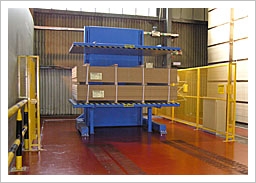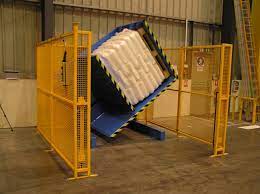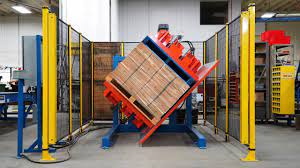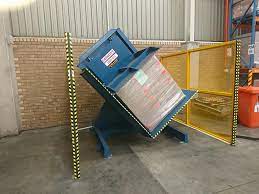Top Reasons Russia Industries Choose Pallet Inverters for rugged designs for cold storage and high throughput
Running a large-scale industrial operation is a constant battle against inefficiency. I remember when I was still an engineer on the factory floor, every minute of downtime felt like a personal failure. A particular challenge was our cold storage facility. Standard equipment would just give up. Hydraulic fluid would thicken, metal would become brittle, and simple tasks like transferring goods from a broken pallet would bring a whole section of our logistics to a grinding halt. This problem doesn't just cause delays. It eats into your profits through damaged goods, high labor costs for manual handling, and the constant threat of missing a shipping deadline. But what if there was a machine specifically built to thrive in these harsh conditions? A pallet inverter with a rugged design is that solution, engineered to maintain high throughput even when the temperature drops far below zero.
Russian industries choose pallet inverters primarily for their robust, rugged designs that guarantee operational reliability in extreme cold storage environments. These machines are built with cold-resistant materials, specialized hydraulic systems, and sealed electronics to prevent failure. This durability, combined with their automated, high-speed cycle times, ensures they can meet the demanding throughput requirements of sectors like food processing, pharmaceuticals, and logistics, where speed and resilience are critical for success. They are not just a piece of equipment; they are a solution to a critical operational bottleneck.

For a leader like you, I know that every equipment decision is scrutinized for its return on investment. You're not just buying a machine; you're investing in uptime, stability, and a stronger supply chain. A standard pallet inverter might look good on a spec sheet in a warm office, but it won't survive a Siberian winter. The real value comes from a machine designed for the environment it will live in. So, let’s dive deeper into the specific engineering choices that make these machines so reliable in Russia and how they deliver the high throughput you need to stay competitive.
Why are rugged designs essential for pallet inverters in Russian cold storage?
Imagine your cold chain comes to a complete stop. The reason is a single, frozen hydraulic line on a critical piece of equipment. Now, you have workers waiting, trucks idling, and valuable temperature-sensitive products at risk. This isn't just an inconvenience; it's a direct threat to your operational margin and reputation. The problem is that standard machinery is not designed to withstand the persistent, biting cold of a commercial freezer or an unheated Russian warehouse in January. This constant exposure creates a cascade of failures, from brittle metal components to failing electronics. The solution is to invest in equipment where a rugged, cold-weather design is not an afterthought, but the core principle of its construction.
Rugged designs are essential because they directly counter the harsh effects of freezing temperatures. They use specialized steel alloys that retain their strength and do not become brittle in the cold. Their hydraulic systems are filled with low-viscosity, arctic-grade oil and equipped with hoses and seals that stay flexible. Furthermore, all critical electronics are housed in heated, IP-rated enclosures to prevent moisture ingress and condensation from freezing on circuit boards. This comprehensive approach ensures the pallet inverter starts, runs, and completes its cycle reliably, every single time, protecting against the costly downtime that plagues less-robust equipment in these environments.

When I started my own factory, one of the first major investments was in equipment for our own dispatch warehouse. I learned very quickly that paying a little more for a machine built for its specific task environment saves you a fortune in the long run. It's about moving from a reactive "fix-it-when-it-breaks" mindset to a proactive strategy of preventing failure from the start. This is especially true for cold storage. Let's break down the specific components that define a truly rugged, cold-storage-ready pallet inverter.
The Science of Cold-Resistant Construction
The foundation of a rugged pallet inverter is its frame and mechanical structure. In sub-zero temperatures, standard carbon steel can undergo a "ductile-to-brittle transition," meaning it loses its ability to absorb shock and can fracture easily under load. A machine designed for Russia’s climate will use specific steel grades with a lower transition temperature, ensuring structural integrity. Welding techniques are also critical. The welds must be free of impurities and performed in a controlled manner to avoid creating stress points that can fail in the cold. The surface treatment is another layer of defense. A simple coat of paint won't do. These machines often feature a multi-layer coating system, starting with a zinc-rich primer and finishing with a durable polyurethane topcoat, to resist the corrosion that can accelerate when ice and condensation are present.
Specialized Components: The Heart of Reliability
Beyond the frame, the operational components are where a rugged design truly proves its worth. A standard hydraulic power pack will fail quickly. The oil will become thick like honey, straining the motor and causing slow, jerky movements, if it moves at all. A cold-storage inverter uses synthetic, arctic-grade hydraulic fluid with a very low pour point. The hoses are made from special polymers that don't stiffen and crack, and the seals are made from materials like low-temp Viton that maintain their elasticity. The electrical system is equally important. Control panels are often housed in heated, NEMA-rated enclosures. This prevents condensation from forming and shorting out PLCs, VFDs, and relays. Even the sensors and limit switches must be rated for low temperatures to ensure they provide accurate signals to the control system.
| Component | Standard Design | Rugged Cold Storage Design | Impact on Reliability |
|---|---|---|---|
| Frame Material | Standard Carbon Steel | Low-Temp Rated Carbon or Stainless Steel | Prevents brittle fracture and structural failure under load. |
| Hydraulic Fluid | ISO 32/46 Mineral Oil | Synthetic, Arctic-Grade Fluid (e.g., ISO 15) | Ensures smooth, consistent fluid flow and prevents pump strain. |
| Hoses & Seals | Standard Nitrile (Buna-N) | Low-Temp Nitrile, Viton, or other specialized polymers | Prevents leaks and system failure from stiff or cracked parts. |
| Electrical Cabinet | Vented, IP54 Enclosure | Sealed, Heated, IP65/66 Enclosure | Protects sensitive electronics from condensation and freezing. |
| Motor | Standard TEFC Motor | Motor with internal heaters or special low-temp grease | Guarantees reliable starts and prevents bearing failure. |
How do pallet inverters achieve high throughput in demanding Russian industries?
In industries like steel, food production, or large-scale distribution, the pace of production is relentless. Your output is measured in tons per hour. The problem is that the final stage of your process—packaging and logistics—can become a major bottleneck. Manually transferring loads from one pallet to another is slow, labor-intensive, and prone to error. This slowdown at the finish line can cause your entire production line to back up, creating a costly traffic jam of finished goods. You have high-speed production, but low-speed dispatch. To solve this, you need a solution that matches the pace of your core operations. A high-throughput pallet inverter is designed to do exactly that, automating the transfer process and clearing the bottleneck.
Pallet inverters achieve high throughput by combining speed, automation, and intelligent design. Their automated cycle can transfer a full pallet load in as little as 60 to 90 seconds, a task that could take multiple workers over 15 minutes to do manually. This speed comes from powerful hydraulics and efficient dual-clamping platforms that secure the load from top and bottom. The "high throughput" aspect is magnified when these machines are integrated into automated production lines. Using conveyors and sensors, a pallet inverter can receive, process, and dispatch pallets without any human intervention, creating a continuous, uninterrupted flow of goods that matches the output of the most demanding industries.

I've seen this firsthand. A client in the steel wire industry was producing coils at a fantastic rate, but their shipping department couldn't keep up. They had to switch from internal wooden pallets to stronger, more expensive steel pallets for shipping, and the manual transfer process was killing their efficiency. By integrating an automated pallet inverter, they turned a 20-minute, two-person job into a 75-second, zero-person automated process. This didn't just speed things up; it freed up two employees for more valuable tasks. Let's look at the specific mechanics that make this level of performance possible.
Deconstructing the High-Speed Cycle
The core of high throughput is the machine's cycle time. A well-designed pallet inverter minimizes every movement. The process starts as a pallet is fed in, often by a conveyor. Sensors detect its position and activate the clamping plates. These plates apply just the right amount of pressure—enough to secure the load without crushing it. The inversion itself, whether it's a 180-degree rotation or a 90-degree tilt-and-lower, is performed by a powerful and precisely controlled hydraulic or electric motor system. Once inverted, the old pallet is released and can be automatically stacked or ejected, while the new pallet is positioned. The load is then gently lowered onto the new pallet, the clamps release, and the finished pallet is conveyed out. Each of these steps is optimized for speed and fluidity, with no wasted motion.
The Power of Automation and Integration
A standalone pallet inverter is fast. An integrated pallet inverter is a force multiplier. This is where it becomes a true asset for a digitally-focused leader like you. Modern pallet inverters are controlled by sophisticated PLCs (Programmable Logic Controllers) that can communicate with your entire factory ecosystem. They can be integrated with:
- Warehouse Management Systems (WMS): The WMS can direct the inverter to perform specific tasks, such as swapping a batch of goods from warehouse pallets to CHEP pallets for a specific customer order.
- Automated Guided Vehicles (AGVs): AGVs can deliver pallets to the inverter and pick them up after the transfer, creating a fully autonomous logistics loop.
- Conveyor Systems: This is the most common integration. Inverters can be placed in-line, acting as a seamless station within a larger conveyor network, without ever interrupting the flow of materials.
This integration is what turns a fast machine into a high-throughput system, capable of handling hundreds of pallets per shift without a single operator touching the controls.
| Feature | Manual Pallet Transfer | High-Throughput Pallet Inverter | Throughput Impact |
|---|---|---|---|
| Time per Pallet | 15-20 minutes | 1-2 minutes | ~10x increase in speed. |
| Labor Required | 2-3 workers | 0-1 operator (for supervision) | Drastically reduces direct labor costs. |
| Consistency | Varies with worker fatigue | Perfectly consistent, every cycle | Predictable output and scheduling. |
| Integration | Manual hand-off | Fully automated with conveyors, AGVs, WMS | Creates a seamless, non-stop flow. |
| Pallets per 8hr Shift | ~25-30 | ~240-400+ | Unlocks true production capacity at the logistics end. |
When you evaluate a piece of equipment, it's easy to focus on the obvious metrics like speed and cost. But as a seasoned business owner, you know the real value is often found in the "hidden" benefits—the second- and third-order effects that don't appear on a standard quote. In a cold storage warehouse, you're not just fighting the cold; you're fighting a host of related problems. Workers are at higher risk of injury on slippery floors, products can be ruined by a single broken pallet, and quality control becomes a slow, painful process. You might think these are just the "costs of doing business" in a cold environment. But a pallet inverter offers a powerful solution to these very problems, delivering value far beyond simple pallet swapping.
The hidden benefits of using pallet inverters in freezing environments are centered on safety, product preservation, and operational efficiency. They drastically improve worker safety by eliminating the need for manual restacking of heavy loads in cold, often icy, conditions. This reduces back injuries and accidents. They also allow you to quickly and easily salvage product by replacing a damaged or contaminated pallet before it leads to a full load spill, preserving valuable inventory. Finally, they streamline quality control by providing 360-degree access to a load, allowing for inspections or removal of a single damaged case without de-staffing the entire pallet.

Thinking back, I saw a client in the frozen food industry who was losing thousands of dollars each month. Not from equipment failure, but from product loss. A forklift would damage the bottom of a wooden pallet, splinters and ice would contaminate the bottom layer of boxes, and they would have to write off the entire pallet load because manually unstacking it for cleaning was too slow and expensive. The introduction of a pallet inverter changed everything. Now, a damaged pallet was a 90-second fix, not a four-figure loss. Let's explore these often-overlooked advantages.
A Leap Forward in Worker Safety and Ergonomics
The cold storage environment is inherently hazardous. Floors can be slippery, visibility can be reduced, and workers wearing bulky clothing have restricted movement. Asking them to manually unstack and restack a 1,000 kg pallet is a recipe for disaster. The most significant hidden benefit of a pallet inverter is the near-total elimination of this manual task. It takes the strain off your employees' backs, reducing the risk of musculoskeletal injuries, which are a leading cause of workers' compensation claims. It also minimizes their exposure time in the coldest parts of the facility. A safer workforce is a more productive and stable workforce, and this directly impacts your operational costs through lower insurance premiums and reduced absenteeism.
Protecting Product Integrity and Reducing Waste
In a freezer, a broken pallet is more than an inconvenience; it's a contamination risk. Wood splinters, ice chunks, or dirt from the floor can compromise an entire load of food or pharmaceutical products. Without an inverter, the choice is often to either risk shipping on a damaged pallet or discard the entire load. An inverter gives you a third, much better option. You can quickly and cleanly transfer the entire stack to a fresh, clean pallet in under two minutes. This allows you to salvage product that would have otherwise been wasted. It also enables you to easily remove a damaged layer of product from the bottom of a stack without disturbing the rest of the load, further reducing spoilage and protecting your profit margins.
Streamlining Quality Assurance and Inventory Management
How do you perform a quality check on a case at the bottom-center of a fully stacked pallet? Manually, it's a nightmare. The pallet has to be completely de-staffed and then restacked. This is so time-consuming that proper quality checks are often skipped. A pallet inverter makes this process simple. You can invert the load, remove the old pallet, perform your inspection or pull a sample, and then place the load back onto the pallet. This makes rigorous quality control practical. It also helps with inventory management systems like FIFO (First-In, First-Out). You can easily rotate stock by inverting a load to access the oldest products, ensuring product freshness and compliance with shelf-life regulations.
| Hidden Benefit Area | Challenge in Cold Storage | How a Pallet Inverter Provides a Solution | Tangible Business Impact |
|---|---|---|---|
| Worker Safety | High risk of slips, falls, and back injuries from manual lifting. | Automates the lifting and transfer process entirely. | Lower workers' comp claims, reduced absenteeism, higher morale. |
| Product Waste | Damaged or contaminated pallets lead to entire load write-offs. | Allows for quick pallet replacement to salvage the product. | Significant reduction in product spoilage and financial loss. |
| Quality Control | Inspections are difficult and time-consuming. | Provides easy, 360-degree access to the entire load. | Improved product quality, better compliance, and fewer returns. |
| Operational Flow | A damaged pallet creates a major bottleneck in the warehouse. | Turns a major disruption into a minor, 2-minute task. | Smoother warehouse operations and less unplanned downtime. |
How Can a Pallet Inverter Become a Strategic Asset Beyond Just Throughput?
As a CEO, you're constantly looking beyond the factory floor to the bigger picture. It's easy for engineers like me to get excited about cycle times and motor specs. But you're asking a more important question: "How does this investment make my entire business stronger?" You might see a pallet inverter as just a machine, a necessary cost to solve a specific problem. But with this view, you risk missing its true potential. If you see it as just another piece of equipment, that's all it will ever be. The real opportunity comes when you view it as a strategic tool, a key that can unlock higher levels of flexibility, sustainability, and data-driven intelligence for your entire operation.
A pallet inverter becomes a strategic asset when it moves beyond its basic function and starts enabling core business objectives. It creates strategic flexibility by allowing you to instantly switch pallet types to meet diverse customer or export requirements without disrupting your workflow. It becomes a pillar of your sustainability goals by facilitating pallet repair and reuse programs, directly reducing waste and procurement costs. Most importantly, in the age of Industry 4.0, it transforms into a vital data-gathering node. When equipped with sensors, it provides real-time insights into your logistics chain, feeding crucial data into your MES or ERP systems for predictive maintenance and enhanced operational visibility.

I've made it my mission to help leaders like you see equipment not just for what it does, but for what it enables. A wrapping machine isn't just about plastic film; it's about load security and brand presentation. In the same way, a pallet inverter isn't just about swapping pallets. It's about making your supply chain more agile, your operations more green, and your factory more intelligent. This is the perspective that separates good companies from great ones. Let’s look at how this single machine can support your biggest strategic goals.
Unlocking True Supply Chain Agility
Your business doesn't operate in a vacuum. You have domestic customers who might use one type of pallet and international customers who require another (e.g., heat-treated ISPM 15 pallets). Or perhaps you want to move towards using plastic pallets for in-house hygiene but use cheaper wooden pallets for one-way shipping. A pallet inverter makes this transition seamless. It decouples your internal pallet standard from your external shipping requirements. This agility allows you to say "yes" to more customers, reduce shipping costs by using the most appropriate pallet for each job, and avoid the massive capital expenditure of trying to standardize your entire pallet pool on a single, expensive type. It turns your pallet choice into a flexible, strategic decision rather than a rigid operational constraint.
A Cornerstone of Your Sustainability and Cost-Reduction Program
Environmental regulations are getting stricter, and customers are increasingly demanding sustainable practices. A pallet inverter is a powerful tool in your environmental, social, and governance (ESG) strategy. Instead of discarding every broken wooden pallet, you can use the inverter to quickly remove them from service. This creates an efficient workflow for a pallet repair program. Repairing a pallet is significantly cheaper and more environmentally friendly than buying a new one. This reduces your consumption of timber, lowers your carbon footprint, and cuts your operational expenses. You can quantify these savings and report them as part of your company's sustainability initiatives, enhancing your brand's reputation while directly improving your bottom line.
A Critical Data Node for Your Digital Transformation
Your goal of deploying MES, IoT sensors, and big data is the right one for the future. A modern pallet inverter can be a key contributor to this vision. When outfitted with the right sensors, it does more than just move loads. It can:
- Weigh every pallet: Providing accurate data for shipping documents and load balancing.
- Count cycles: Feeding data into your predictive maintenance schedule for itself and for associated equipment like conveyors.
- Log fault codes: Alerting maintenance teams to potential issues before they cause downtime.
- Communicate with your MES: Linking a specific pallet transfer to a specific work order, providing end-to-end traceability.
This data transforms the inverter from a "dumb" machine into an intelligent asset that provides the visibility you need to optimize your entire production process. It becomes a critical touchpoint in your journey towards a fully connected, smart factory.
| Strategic Area | Operational Function of Pallet Inverter | Strategic Advantage for the CEO |
|---|---|---|
| Supply Chain Agility | Switches between pallet types (wood, plastic, export, etc.). | Can pursue new markets and meet diverse customer needs without retooling. |
| Sustainability (ESG) | Facilitates pallet removal for repair and reuse programs. | Lowers operational costs, reduces waste, and strengthens brand reputation. |
| Digitalization | Gathers data on weight, cycles, and status. | Provides real-time data for MES/ERP, enabling predictive maintenance and OEE. |
| Cost Control | Salvages product from damaged pallets. | Directly reduces inventory write-offs and improves profit margins. |
Conclusion
Ultimately, a rugged pallet inverter is not just a piece of equipment. It is a strategic investment in reliability, throughput, and long-term growth for any industry facing demanding environments.


